A classic style has always been about elegance and luxury appeal. In its different aesthetic options and in every furnishing context it shows its versatile, timeless and charming character.
Of all the stylistic variations, there is one in particular that fascinates: the neoclassical style. A furnishing style that can 'dress' every room with sumptuous luxury and elegance in a balanced formula.
And perhaps it is balance that is the most cherished characteristic of this style. Balance understood as the ability to combine luxury and sobriety.
The neoclassical style is elegant and sophisticated in its simplicity and its formal rigour, but does not disdain luxurious touches.
No wonder: in interior design, the neoclassical style was born as a reaction to the glitz of the Baroque and Rococo periods, proposing more rational forms, straight (rather than rounded) lines and more restrained tones, but still not entirely immune to the era's need for luxury and elegance.
This is why neoclassicism is the most hybrid of styles, and, for this reason, also among the most complex, ductile and versatile.
People love versatility because it allows them to choose between different sides of the same coin: neoclassicism expresses opulence and elegance, it is a symbol of luxury and prestige, but at the same time it is also the most 'contemporary' of the classical styles, because it offers an uncluttered vision, geometric shapes, clean lines and more balance than other connotations of the classical world.
And here we go back to the initial word - balance.
We must conclude that this is the word that best sums up the varied personality of the neoclassical style.
All that remains is to learn more about it, and discover how to apply its characteristics to today's living spaces.
We will focus on the dining room furniture and, specifically, on the table choice given that the table is the true protagonist of this interior design style.
- Tips to set the right neoclassical concept in your dining room
- 4 Aspects to consider before choosing a neoclassical dining table
- Neoclassical dining table: the central element you need to complete the furnishing of your dining room
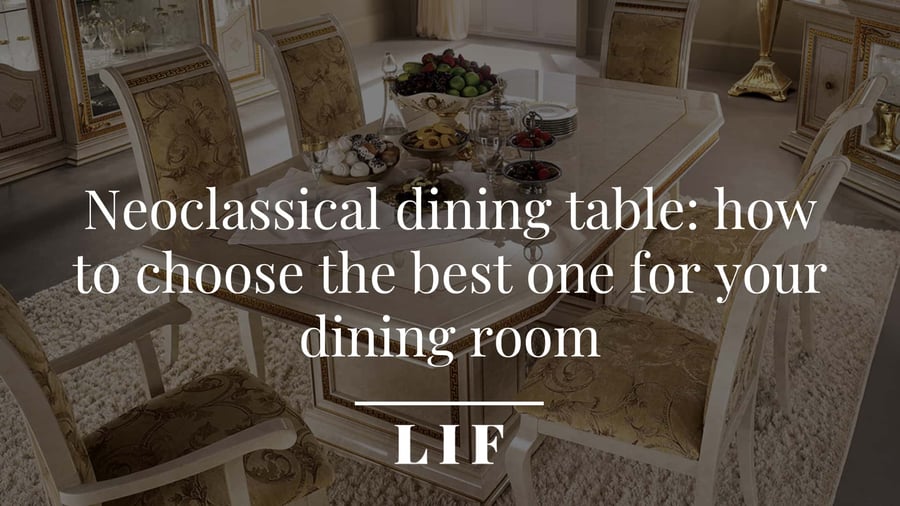
Tips to set the right neoclassical concept in your dining room
Before we focus on choosing the ideal table for your dining room, let's try to make a premise on the conceptual meaning of 'neoclassical style'.
Thinking about the roots and key elements of the style will help us enter the neoclassical 'mood', assimilating the stylistic rules and capturing its typical atmosphere. Every style has one. Country is warm and rustic, the Bohemian style is exuberant and creative, shabby-chic is recognisable by its romantic and dreamy atmosphere.
Neoclassical, as the combination of the two terms 'new' and 'classical' suggests, conveys a dual message.
On the one hand, we have the reference to traditions and the classic Italian style, steeped in elegance, luxury and stylistic refinement. On the other, there is the irruption of the new, which brings greater attention to the comfort of using furniture, respect for proportions, and creating environments that are also functional, as well as beautiful and ornate.
Therefore, if you want to furnish an interior in the neoclassical style, you must be willing to travel on the very thin thread of this ambivalence, never leaning to one side or the other.
This is the essence of neoclassical style: like a skilful equilibrist, in every choice - from colours to lighting, from sofa configuration to the organisation of furnishing accessories - and in every furnishing solution, including the dining room table, you will have to find the right compromise between aesthetics and pragmatism.
The following are a series of stylistic tricks and tips that will help you in the task of designing the perfect neoclassical-style dining room.
Let's get started!
Setting the right colour palette
As a first design step, it is necessary to set the right colour palette suitable to the furnishing context.
The neoclassical style calls for a range of soft, neutral colours such as cream, ivory, gold and silver. Shades of this type add aesthetic depth to your dining room.
In addition to visually enlarging the space, light palettes increase the brightness of rooms and contribute to making them more elegant and sophisticated.
The dining room, in particular, as both a convivial space and a representative environment in which to show off the 'starring' pieces of furniture, from precious display cabinets to sideboards, passing through large table (perhaps the most representative element of the room) surrounded by elegant seating, also needs to be enhanced through colour choices. And light colours are undoubtedly the most suitable for creating classy, liveable and cosy environments.
Starting with a light base, it is then possible to play on contrasts by adding details or complements in warmer tones - gold, bronze, shades of brown - or by mixing cold, shiny materials, such as marble and metals, with 'living' surfaces that convey a feeling of greater warmth and cosiness, such as wood essences.
The colours typical of the Neoclassical style help to brighten up the room and emphasise the purity of this classic yet modern style.
Combining classical and modern elements
One of the hallmarks of Neoclassical style, also known as modern classicism, is the ability to bring together elements of the past and elements of the present in a harmonious and spontaneous way.
In today's homes, this mixture can be recreated in various ways.
For example, you could decorate the ceiling with elegant stucco and modernise it with a recessed spotlight system with LED lighting.
Another way of expressing the classic-modern dualism is to enhance the natural brightness of neoclassical rooms, given by the presence of large windows or glass walls, with an artificial lighting system that includes both modern design lighting points, such as LED wall lights, and more traditional elements, such as a luxurious ceiling chandelier, which echoes the materials and shapes of the 18th century aesthetic.
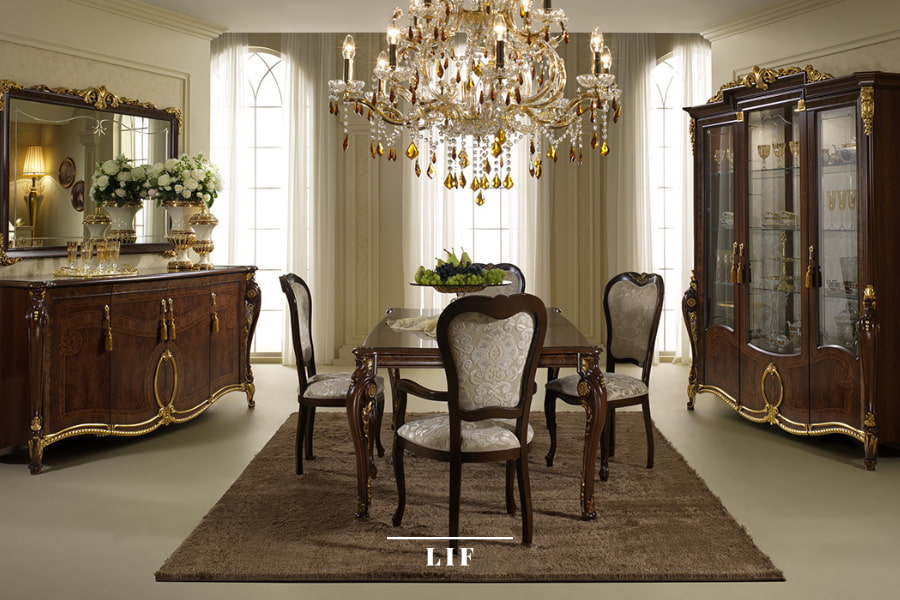
Give preference to furniture with precious decorative details: friezes, cymas and columns
In its reinterpretation of classical models in a contemporary key, this style draws in particular on Greek and Roman architecture.
By incorporating elements typical of the classical era - stuccoes, friezes, arches, columns, cornices - into the dining room, you will create the perfect basis for the elegant and solemn atmosphere that the Neoclassical style requires.
With the techniques available today, you could also avoid masonry work by resorting to simple yet visually striking solutions, such as wallpapers with a three-dimensional effect.
To complete your modern classic dining room, you could also think of an elegant wall panelling to decorate the walls, complemented with special accessories, such as a large mirror with a gilded frame and furniture elements whose design synthesises the concept of 'functional luxury'.
Like the sideboard from Arredoclassic's Liberty collection in which the form of the structure, simple and functional, becomes luxurious and 'monumental' thanks to the decorative elements - gilded friezes, frames, friezes, geometric decorations - and the precious finishes.
Or like the living room furniture in the Fantasia collection, which makes it possible to recreate the sumptuous atmospheres of the Empire and Neoclassical styles, while maintaining a balanced and harmonious vision.
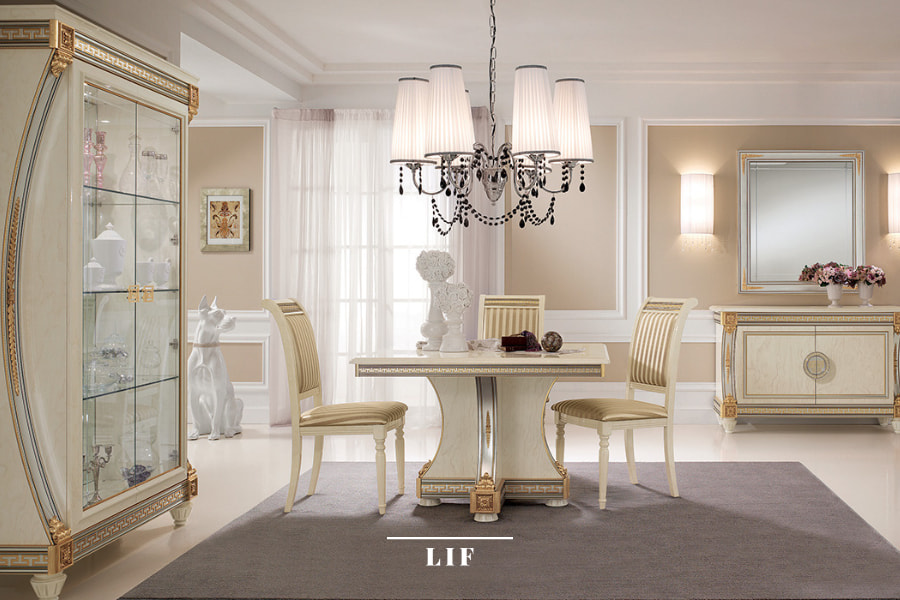
Place a large classic-style rug in the dining room
To complete the composition, you could place tables and chairs on a large classical-style rug. Make sure that the rug is large enough to host the dining table and chairs.
A decorative touch that will not go unnoticed and will add comfort and style to your dining room.
The advice is to choose carpets made of high quality fabrics, akin to the neo-classical style, such as, for example, Persian or Caucasian carpets.
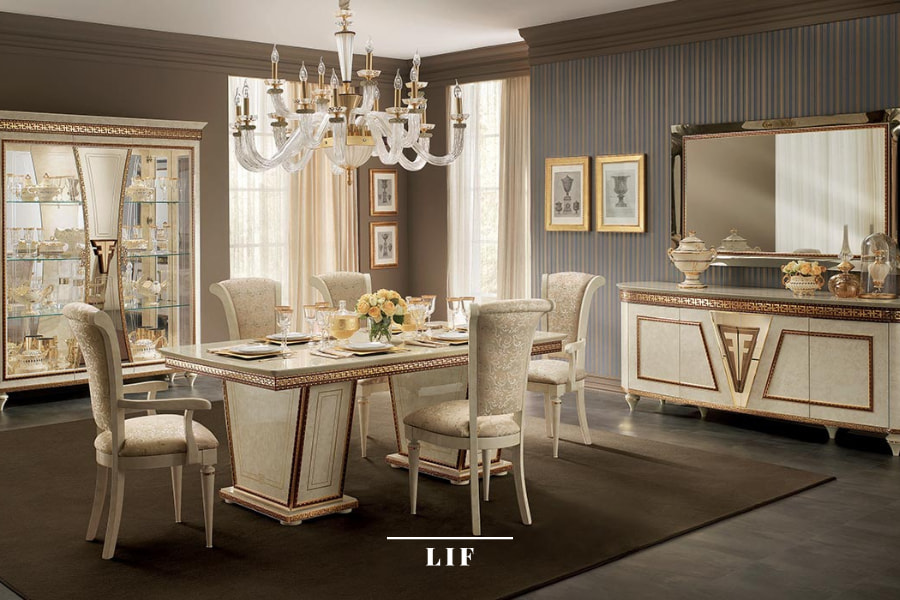
4 Aspects to consider before choosing a neoclassical dining table
Tables and chairs together form a fundamental part of the dining. In order for them to match the style of the furniture, they must meet the neoclassical style rules.
Basically, the dining table is the focal point of the dining room, so there will be several aspects to take into account when making the right choice from size and shape to material.
Let go over each one of them in detail.
1. The size of the room
First of all, it is critical to assess the size of the space where the dining set will be placed. This will give you an idea of the size of the dining table you need.
Ideally, the distance between the edge of the dining table and the wall, or any other piece of furniture, should be roughly one metre. This will allow you to have enough space to move around freely, move the chairs and have enough space to walk around the table.
As we know, proportions are fundamental in the economy of an interior design project. Therefore, the size of the table must necessarily be related to the size of the room, in order to maintain a harmonious vision and contribute to the functionality of the room.
On the other hand, it would make no sense to do otherwise. Try to imagine a very large table compressed into a small room, or, conversely, a small table lost in the vastness of a huge living room: there is nothing elegant about such a choice, not to mention that the very function (and aesthetics) of the table would lose value.
2. The shape of the table to suit the room
Respect for proportions when choosing the table size goes hand in hand with the choice of its shape.
If you have limited space, we recommend a 36-44 inch square four-seater table, a round table with a 36-48 inch diameter or a versatile table such as the Melodia collection which is available in both round and oval shapes, and in both fixed and extendable versions.
You could also choose a triangular-shaped table. These models can accommodate up to 6 people depending on their position and size.
If you have enough space, a 72 inch long rectangular table will be the ideal choice to accommodate six people, while a 96 inch long rectangular table can comfortably accommodate eight people.
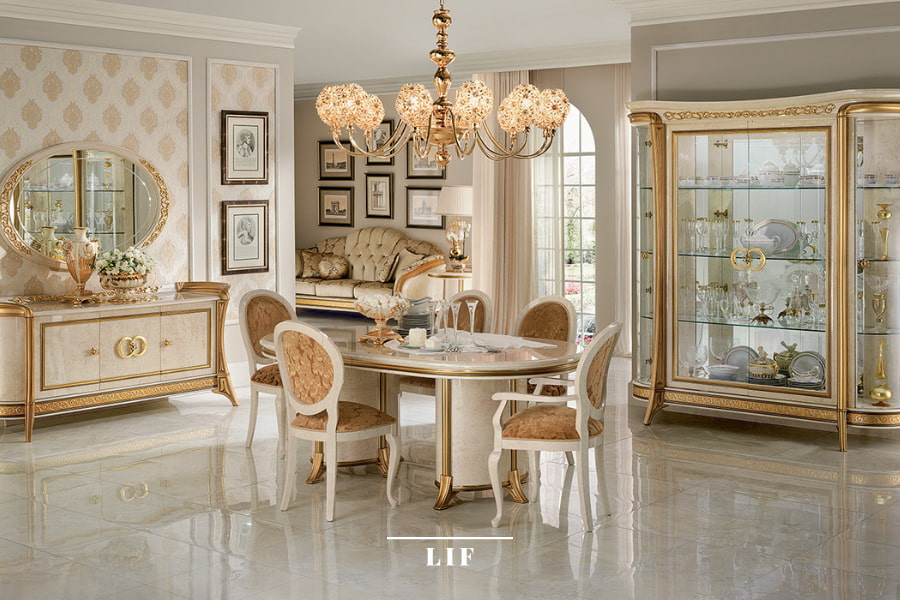
3. The material and finishes
The choice of material and finishes is an important decision to take in this case, taking into consideration the neoclassical furnishing concept and therefore an entire series of related aesthetic factors.
Like, for example:
- Wall and/or wallpaper colour
- Floor colour and finish
- Design of the remaining furnishings that make up the composition
If, for example, the colour of the walls and floor were in brown or warm beige shades, as we see in the Fantasia dining room, the best choice for the dining table could be a glossy finish and an ethereal colour such as ivory, to create a striking colour contrast and balance the 'temperature' of the colour palette: neither too warm nor too cold.
In this way, we will have a warm base (shades of brown), ideal for welcoming guests, and light and shiny nuances for the furniture, which must express luxury and wealth, as shown by the precious fabrics of the seats, the decorative friezes and the gold finish of the table and the other furnishings in the composition.
If you like wood, we recommend that you always opt for hard and strong woods such as walnut, mahogany or oak. If, on the other hand, you want to opt for a more understated and elegant material, choose a table with a glass top, ideal for different types of decorations.
And, since glass tables are reflective, they add a lighter, brighter touch to the room.
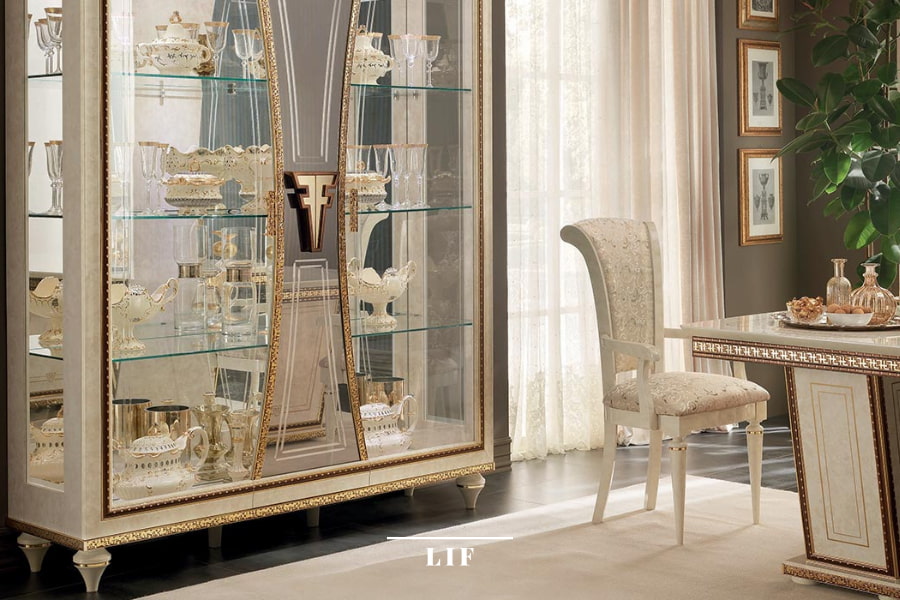
4. What sort of seats should be combined with the table
The ideal way to choose dining room seats would be to buy the entire set, or choose chairs that match the table perfectly.
If you're in a daring mood, let your creativity and the desire to create new combinations run loose: choose chairs from another collection and match them with the table using aesthetic criteria.
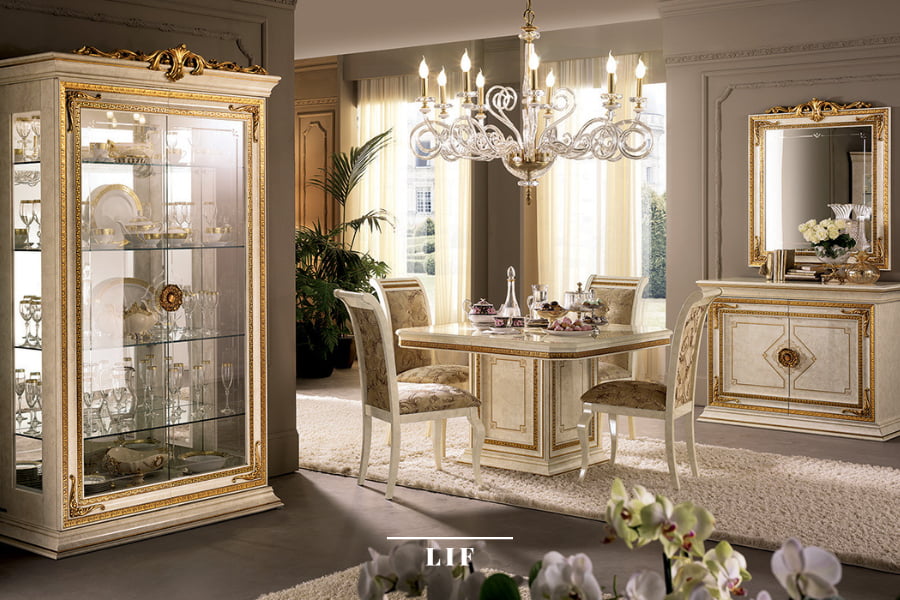
Neoclassical dining table: the central element you need to complete the furnishing of your dining room
In this article, we saw the main stylistic rules to follow in order to recreate the refined and solemn atmosphere of Neoclassical style in modern homes. In particular, we focused on furnishing the dining room, one of the most representative rooms in the home.
We have also seen how it is not enough to follow the rules to achieve good results in interior design.
Rather than applying theory slavishly, you should be able to unearth the true essence of the style you wish to recreate and then interpret it by adapting it to your own personality and the characteristics of the home.
In this case, it is a matter of finding a double essence, as Neo-classical style reinterprets the typical elements of Greco-Roman architecture in a contemporary key, and in doing so draws on the balance and equilibrium of the various elements of the furniture design.
The shapes are simple and functional, as the contemporary mood demands, but the quality of the materials, the decorations and the luxurious finishes speak the language of timeless elegance.
Recreating a Neoclassical interior is by no means simple. There is always the risk of creating environments that are either too classical or too modern, or, even worse, hybrids without a real soul.
That is why, if you want to create a dining room in perfect neoclassical style, and if you want to maintain the formal balance we have discussed in this article, you have to play it safe by choosing the best.
Arredoclassic collection seach with its own special features, are synonymous with quality, refinement, Made in Italy taste and timeless beauty.
Choose the one that best suits your personality and start decorating.



